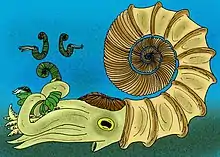Tropaeum
Tropaeum is an extinct genus of ammonites found throughout the oceans of the world during the Early Cretaceous. As with many other members of the family Ancyloceratidae, there was a trend among species within this genus to uncoil somewhat, in a very similar manner to the genus Lytoceras. The largest species, T. imperator of Australia, had a shell a little over one meter in diameter.
| Tropaeum Temporal range: Early Cretaceous | |
|---|---|
 | |
| Tropaeum imperator | |
| Scientific classification | |
| Kingdom: | Animalia |
| Phylum: | Mollusca |
| Class: | Cephalopoda |
| Subclass: | †Ammonoidea |
| Order: | †Ammonitida |
| Suborder: | †Ancyloceratina |
| Family: | †Ancyloceratidae |
| Genus: | †Tropaeum Sowerby, 1837 |
| Species | |
| |
The name "Tropaeum" was applied by paleontologist James De Carle Sowerby, in 1837.
References
This article is issued from Wikipedia. The text is licensed under Creative Commons - Attribution - Sharealike. Additional terms may apply for the media files.